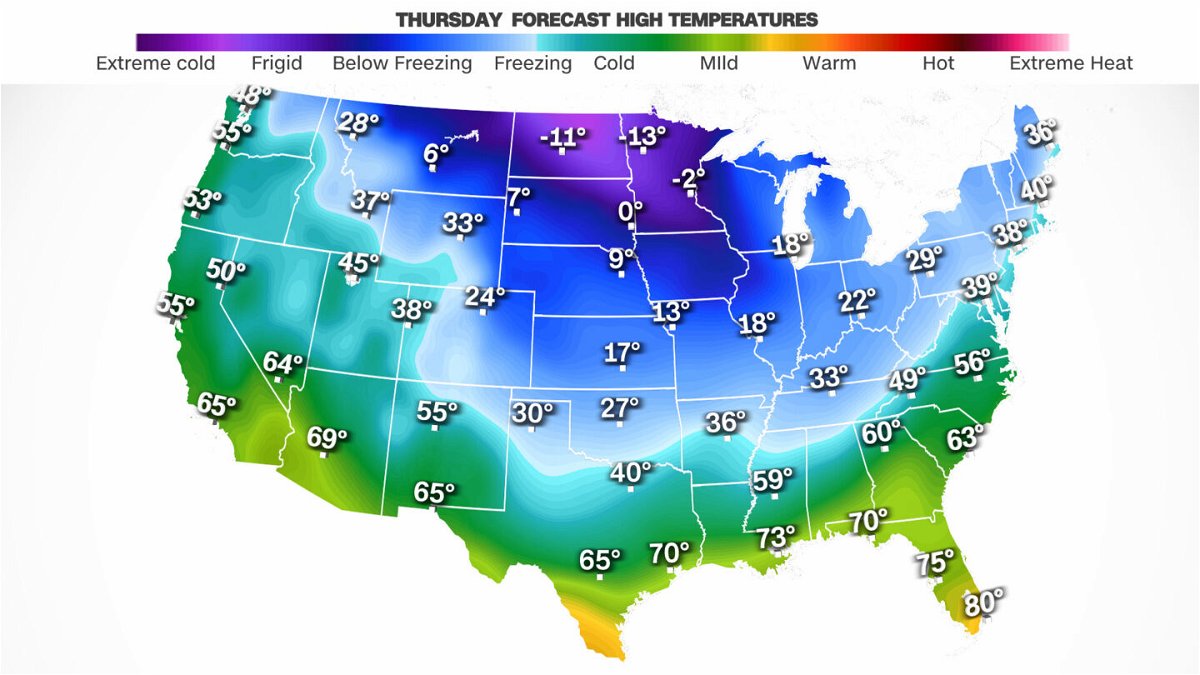Nearly 100 million people are under winter alerts from coast to coast

The western US has hardly seen a break over the past several weeks after being pummeled by record-breaking rain and snow from Washington down to California.
By Allison Chinchar and Taylor Ward, CNN Meteorologists
Winter weather alerts stretched from coast to coast Thursday with nearly 100 million people impacted as multiple storm systems moved across the US.
There are two separate storm systems hitting both sides of the country and plunging temperatures across the central US, so let’s break down the potential hazards in each region.
Bookmark this site to check if snow is forecast for your region
Too much of a good thing for some states
The West has hardly seen a break over the past several weeks after being pummeled by record-breaking rain and snow from Washington down to California. The cumulative effect of all that rain and snow will increase the threat for river flooding and avalanches.
According to tweets from the Washington state Department of Transportation, “extreme weather has created conditions so hazardous that it’s too dangerous for our crews to be in the mountain pass areas. Because of that, Snoqualime, Stevens, White & Blewett passes will not reopen until at least Friday & possibly not until Saturday. Additionally, SR 14 and Oregon’s I-84 in the Columbia River Gorge, are also closed to freight traffic, with I-84 closed to ALL vehicles. This means cross-state travel is almost completely impossible.”
The Northwest Avalanche Center in Seattle is warning that large natural avalanches will occur at all elevations of the Cascades, Olympics and Mount Hood. The center warns that backcountry travel is not recommended at this time.
The rain and snow are very helpful in terms of mitigating drought conditions, but too much in a short period of time is far from helpful.
“All in all, this rain, combined with the snowmelt from the coastal mountains and to some degree, the lower slopes of the Cascades, will push many rivers upward, some potentially reaching near flood stage,” the National Weather Service office in Portland, Oregon, said.
Southern snow equals travel troubles
After a very mild Christmas week across much of the southern US, the new year is trying to give winter a comeback.
“Today, a wave of low pressure is forecast to develop along the arctic front draped across the Deep South,” the Weather Prediction Center said Thursday morning. “The combination of snow and ice may cause hazardous road conditions through tonight in this region.”
By late Thursday afternoon, much of Kentucky and northern Tennessee were blanketed in four to eight inches of fresh snowfall. The snow led to snarled traffic and accidents in Nashville and Lexington, Kentucky.
Kentucky State Police are working on clearing what they describe as a more than 20-car pileup on the Western Kentucky Parkway during winter weather conditions.
Officer Scotty Sharp told CNN that the parkway was closed in both directions near mile marker 131 in Elizabethtown.
“The only injuries being reported at this time are minor non-life threatening,” Sharp said.
Sharp said the highways are covered in snow with a temperature of 20 degrees. “I have no doubt that there is ice under that snow, and the snow is still coming down,” he said.
By Thursday evening, the snow will wind down in Tennessee and Kentucky as the system begins to shift into the Mid-Atlantic region.
Even more snow up north
By Friday morning, the low-pressure system will move off the Mid-Atlantic coast and begin to rapidly deepen offshore, causing accumulating snow to spread from the Mid-Atlantic into the Northeast.
“The storm track for an approaching coastal low pressure system is beginning to become more clear,” the NWS office in Boston said. “At this time it appears as though this system will pass just south and east of the 40N/70W benchmark. This will support accumulating snowfall for almost all of southern New England.”
There are some uncertainties, though. The NWS office in New York points out that any shift in the track of the storm will modify snowfall amounts. For example, if the track shifts slightly closer to the coast, that could increase amounts, especially across Long Island and southern Connecticut, but a track slightly to the east out to sea, could result in lesser amounts.
Another question mark with the forecast will be whether any heavier snowbands develop, such as snow squalls.
In Virginia, Governor Ralph Northam declared a state of emergency Wednesday evening and the National Guard is being mobilized to assist with emergency management as the state faces its second winter storm this week.
In anticipation of the winter storm, Maryland and Virginia Health officials announced changes at their testing and vaccination sites. The Maryland Department of Health will delay operating times at various locations Friday and it urged customers to verify operating status of any site prior to visiting. Five Virginia Community Vaccination Centers will be closed on Friday.
In Massachusetts, government officials are directing all non-emergency state employees who work in executive branch agencies not to report to their workplaces Friday. Boston Public Schools are closed.
“The Administration is urging residents to stay off roadways and to use public transportation when possible as the storm moves across the Commonwealth beginning late tonight and through tomorrow,” said a statement released by the office of Gov. Charlie Baker and Lt. Gov. Karyn Polito.
New Jersey Gov. Phil Murphy announced a state of emergency effective at 10 p.m. Thursday evening as the state expects to receive about six inches of snow.
That same low pressure system will generate gusty winds across the Northeast as we head into the weekend.
It may be January, but the Great Lakes don’t know that. They are still quite warm, relatively speaking, and that means lake effect snow will also be in full gear as another low pressure system slides by the region.
“A low pressure system lifting into eastern Canada will allow for heavy lake effect snow as chilly westerly winds blow over the still relatively warm lakes,” the WPC said. ” Favorable locations downwind of the lakes could see 6 to 12 inches of snow by Saturday morning, with locally higher amounts.”
The polar plunge
In the Southeast, the snow usually melts as quickly as it arrives, so you don’t have long to enjoy it. In this case, the snow will be lingering thanks to the temperatures taking a polar plunge.
“Sub-zero daytime highs will engulf the northern Plains today while temperatures as much as 20-25 degrees below normal will overspread the central Plains, parts of the southern Plains, and eastward into the Midwest and Ohio Valley on Friday,” the WPC said.
Even cities as far south as Atlanta, Memphis, Tennessee, and Huntsville, Alabama, will barely get above the freezing mark for high temperatures on Friday.
East of the Rockies, the below average temperatures will extend all the way from the Canadian border down to the Gulf Coast, except for Florida.
The-CNN-Wire
™ & © 2022 Cable News Network, Inc., a WarnerMedia Company. All rights reserved.
CNN’s Amy Simonson, Jessica Jordan, Jaide Garcia and Sahar Akbarzai contributed to this report.

